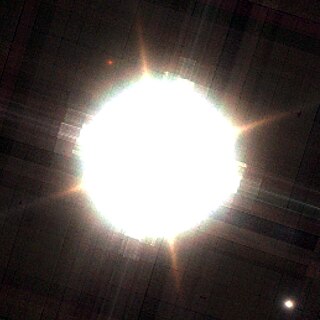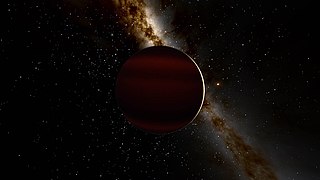
Brown dwarfs are substellar objects that have more mass than the biggest gas giant planets, but less than the least massive main-sequence stars. Their mass is approximately 13 to 80 times that of Jupiter (MJ)—not big enough to sustain nuclear fusion of ordinary hydrogen (1H) into helium in their cores, but massive enough to emit some light and heat from the fusion of deuterium (2H). The most massive ones can fuse lithium (7Li).

A rogueplanet, also termed a free-floating planet (FFP) or an isolated planetary-mass object (iPMO), is an interstellar object of planetary mass which is not gravitationally bound to any star or brown dwarf.

A sub-brown dwarf or planetary-mass brown dwarf is an astronomical object that formed in the same manner as stars and brown dwarfs but that has a planetary mass, therefore by definition below the limiting mass for thermonuclear fusion of deuterium . Some researchers call them rogue planets whereas others call them planetary-mass brown dwarfs. They are sometimes categorized as Y spectral class brown dwarfs.

HD 129116 is a binary star in the northeastern part of Centaurus, east of Menkent. It is also known by its Bayer designation of b Centauri, while HD 129116 is the star's identifier in the Henry Draper catalogue. This object has a blue-white hue and is faintly visible to the naked eye with an apparent visual magnitude of +4.01. It is located at a distance of approximately 325 light years from the Sun based on parallax, and has an absolute magnitude of −1.07.

Oph 162225-240515, often abbreviated Oph 1622, and also known as Oph 11, is a pair of brown dwarfs that have been reported as orbiting each other. The bodies are located in the constellation Scorpius and are about 400 light years away. Mass estimates of the two objects are uncertain, but they are probably each higher than the brown-dwarf/planet dividing line of 13 Jupiter masses. Oph1622B is located 1.94 arcseconds from Oph1622A, at a position angle of 182°.

The Scorpius–Centaurus association is the nearest OB association to the Sun. This stellar association is composed of three subgroups and its distance is about 130 parsecs or 420 light-years. Using improved Hipparcos data, Rizzuto and colleagues analysed nearby stars more closely, bringing the number of known members to 436. They doubt the need to add a subclassification because they found a more continuous spread of stars.

The brown-dwarf desert is a theorized range of orbits around a star within which brown dwarfs are unlikely to be found as companion objects. This is usually up to 5 AU around solar mass stars. The paucity of brown dwarfs in close orbits was first noted between 1998 and 2000 when a sufficient number of extrasolar planets had been found to perform statistical studies. Astronomers discovered there is a distinct shortage of brown dwarfs within 5 AU of the stars with companions, while there was an abundance of free-floating brown dwarfs being discovered. Subsequent studies have shown that brown dwarfs orbiting within 3–5 AU are found around less than 1% of stars with a mass similar to the Sun (M☉). Of the brown dwarfs that were found in the brown-dwarf desert, most were found in multiple systems, suggesting that binarity was a key factor in the creation of brown-dwarf desert inhabitants.
Chi Lupi is a spectroscopic binary star in the constellation of Lupus. It has an apparent visual magnitude of approximately 3.957. The primary star in the binary is a mercury-manganese star of spectral type B9.5V; the secondary is a metallic-lined star of type A2Vm.

1RXS J160929.1−210524 is a pre-main-sequence star approximately 450 light-years away in the constellation of Scorpius.

A planetary-mass object (PMO), planemo, or planetary body is, by geophysical definition of celestial objects, any celestial object massive enough to achieve hydrostatic equilibrium, but not enough to sustain core fusion like a star.
Deuterium fusion, also called deuterium burning, is a nuclear fusion reaction that occurs in stars and some substellar objects, in which a deuterium nucleus and a proton combine to form a helium-3 nucleus. It occurs as the second stage of the proton–proton chain reaction, in which a deuterium nucleus formed from two protons fuses with another proton, but can also proceed from primordial deuterium.
HIP 78530 b is an object that is either a planet or a brown dwarf in the orbit of the star HIP 78530. It was observed as early as 2000, but the object was not confirmed as one in orbit of the star HIP 78530 until a direct imaging project photographed the star in 2008. The image caught the attention of the project's science team, so the team followed up on its initial observations. HIP 78530 b orbits a young, hot, bright blue star in the Upper Scorpius association. The planet itself is over twenty-three times more massive than Jupiter, orbiting eighteen times further from its host star than Pluto does from the Sun by the estimates published in its discovery paper. In this predicted orbit, HIP 78530 b completes an orbit every twelve thousand years.

HD 115600 is a star in the constellation Centaurus and a member of the Scorpius–Centaurus association, the nearest OB association to the Sun and the host star of a bright Kuiper belt-like debris ring.

K2-33 is an extremely young pre-main-sequence star located about 456 light-years (140 pc) away from the Earth in the constellation of Scorpius. It is known to host one planet, a super-Neptune, named K2-33b. It is also notable for its young age.
HD 142250 is a star in the constellation Scorpius. It has a visual apparent magnitude of 6.1, being visible to the naked eye only in excellent seeing conditions. From parallax measurements, it is located 486 light-years (149 parsecs) away from Earth. This distance, together with the star's proper motion, indicate that HIP 77900 is a member of the Upper Scorpius subgroup of the Scorpius–Centaurus association, the nearest OB association to the Sun. This subgroup is the youngest of the three of the association, with an estimated age of 11 million years.

2MASS J11011926–7732383 AB is a brown dwarf binary about 600 light-years distant in the Chamaeleon. constellation. The wide binary pair is separated by about 240 astronomical units. The system was the first discovery of a brown dwarf binary with a separation greater than 20 au. The discovery gave fundamental insights into the formation of brown dwarfs. Previously it was thought that such wide binary brown dwarfs are not formed or at least are disrupted at ages of 1-10 Myrs. Together with other wide binaries, such as Oph 162225-240515 or UScoCTIO 108, the existence of this system was inconsistent with the ejection hypothesis, a proposed hypothesis in which brown dwarfs form in a multiple system, but are ejected before they gain enough mass to burn hydrogen. The ejection hypothesis predicted a maximum separation of 10 au for brown dwarf binaries.

WISE 2150–7520 AB is a binary brown dwarf 78.9 light-years distant from Earth in the southern constellation Octans. The system is a wide binary with a separation of 341 astronomical units. The primary of the system was discovered in 2005 as an infrared object with high proper motion and in 2008 was found to be an ultracool dwarf with a spectral type of L. The secondary, a much cooler T dwarf, was discovered by volunteers of the citizen science project Backyard Worlds: Planet 9, using data from the Wide-field Infrared Survey Explorer (WISE). The system was followed up by the project scientists with Magellan and Spitzer and a scientific paper describing the binary was published in the Astrophysical Journal in 2020.
HIP 79098 is a binary star in the constellation Scorpius. It has a visual apparent magnitude of +5.88, being visible to the naked eye under very dark skies. From parallax measurements by the Gaia spacecraft, it is located approximately 500 light-years from Earth.














